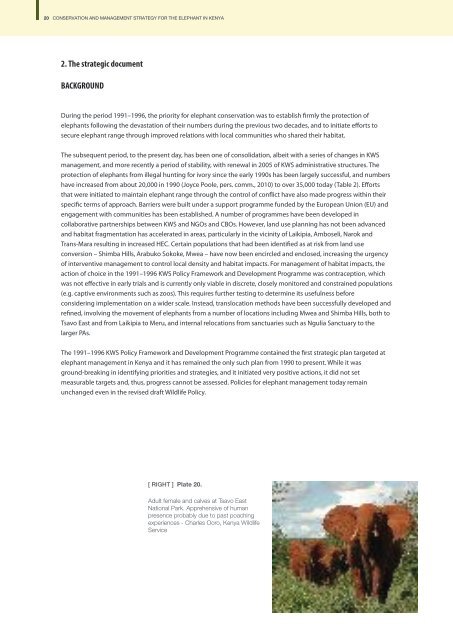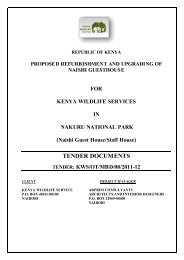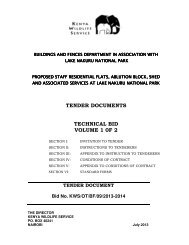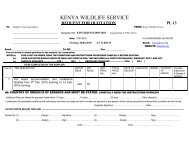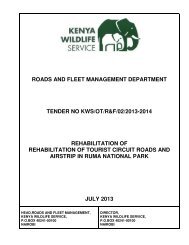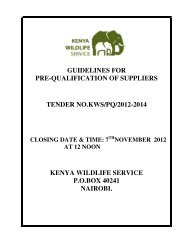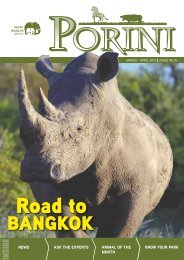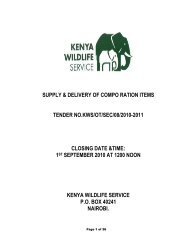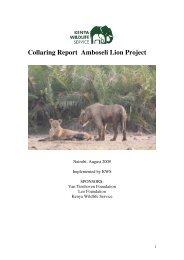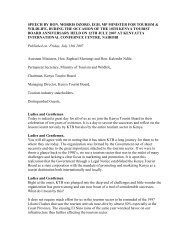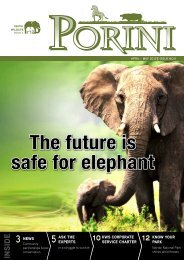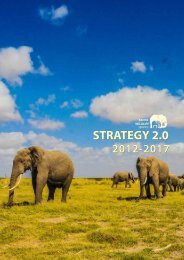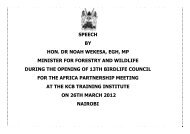Conservation and Management Strategy for the Elephant in Kenya
Conservation and Management Strategy for the Elephant in Kenya
Conservation and Management Strategy for the Elephant in Kenya
Create successful ePaper yourself
Turn your PDF publications into a flip-book with our unique Google optimized e-Paper software.
20 CONSERVATION AND MANAGEMENT STRATEGY FOR THE ELEPHANT IN KENYA<br />
2. The strategic document<br />
BACKGROUND<br />
Dur<strong>in</strong>g <strong>the</strong> period 1991–1996, <strong>the</strong> priority <strong>for</strong> elephant conservation was to establish firmly <strong>the</strong> protection of<br />
elephants follow<strong>in</strong>g <strong>the</strong> devastation of <strong>the</strong>ir numbers dur<strong>in</strong>g <strong>the</strong> previous two decades, <strong>and</strong> to <strong>in</strong>itiate ef<strong>for</strong>ts to<br />
secure elephant range through improved relations with local communities who shared <strong>the</strong>ir habitat.<br />
The subsequent period, to <strong>the</strong> present day, has been one of consolidation, albeit with a series of changes <strong>in</strong> KWS<br />
management, <strong>and</strong> more recently a period of stability, with renewal <strong>in</strong> 2005 of KWS adm<strong>in</strong>istrative structures. The<br />
protection of elephants from illegal hunt<strong>in</strong>g <strong>for</strong> ivory s<strong>in</strong>ce <strong>the</strong> early 1990s has been largely successful, <strong>and</strong> numbers<br />
have <strong>in</strong>creased from about 20,000 <strong>in</strong> 1990 (Joyce Poole, pers. comm., 2010) to over 35,000 today (Table 2). Ef<strong>for</strong>ts<br />
that were <strong>in</strong>itiated to ma<strong>in</strong>ta<strong>in</strong> elephant range through <strong>the</strong> control of conflict have also made progress with<strong>in</strong> <strong>the</strong>ir<br />
specific terms of approach. Barriers were built under a support programme funded by <strong>the</strong> European Union (EU) <strong>and</strong><br />
engagement with communities has been established. A number of programmes have been developed <strong>in</strong><br />
collaborative partnerships between KWS <strong>and</strong> NGOs <strong>and</strong> CBOs. However, l<strong>and</strong> use plann<strong>in</strong>g has not been advanced<br />
<strong>and</strong> habitat fragmentation has accelerated <strong>in</strong> areas, particularly <strong>in</strong> <strong>the</strong> vic<strong>in</strong>ity of Laikipia, Amboseli, Narok <strong>and</strong><br />
Trans-Mara result<strong>in</strong>g <strong>in</strong> <strong>in</strong>creased HEC. Certa<strong>in</strong> populations that had been identified as at risk from l<strong>and</strong> use<br />
conversion – Shimba Hills, Arabuko Sokoke, Mwea – have now been encircled <strong>and</strong> enclosed, <strong>in</strong>creas<strong>in</strong>g <strong>the</strong> urgency<br />
of <strong>in</strong>terventive management to control local density <strong>and</strong> habitat impacts. For management of habitat impacts, <strong>the</strong><br />
action of choice <strong>in</strong> <strong>the</strong> 1991–1996 KWS Policy Framework <strong>and</strong> Development Programme was contraception, which<br />
was not effective <strong>in</strong> early trials <strong>and</strong> is currently only viable <strong>in</strong> discrete, closely monitored <strong>and</strong> constra<strong>in</strong>ed populations<br />
(e.g. captive environments such as zoos). This requires fur<strong>the</strong>r test<strong>in</strong>g to determ<strong>in</strong>e its usefulness be<strong>for</strong>e<br />
consider<strong>in</strong>g implementation on a wider scale. Instead, translocation methods have been successfully developed <strong>and</strong><br />
ref<strong>in</strong>ed, <strong>in</strong>volv<strong>in</strong>g <strong>the</strong> movement of elephants from a number of locations <strong>in</strong>clud<strong>in</strong>g Mwea <strong>and</strong> Shimba Hills, both to<br />
Tsavo East <strong>and</strong> from Laikipia to Meru, <strong>and</strong> <strong>in</strong>ternal relocations from sanctuaries such as Ngulia Sanctuary to <strong>the</strong><br />
larger PAs.<br />
The 1991–1996 KWS Policy Framework <strong>and</strong> Development Programme conta<strong>in</strong>ed <strong>the</strong> first strategic plan targeted at<br />
elephant management <strong>in</strong> <strong>Kenya</strong> <strong>and</strong> it has rema<strong>in</strong>ed <strong>the</strong> only such plan from 1990 to present. While it was<br />
ground-break<strong>in</strong>g <strong>in</strong> identify<strong>in</strong>g priorities <strong>and</strong> strategies, <strong>and</strong> it <strong>in</strong>itiated very positive actions, it did not set<br />
measurable targets <strong>and</strong>, thus, progress cannot be assessed. Policies <strong>for</strong> elephant management today rema<strong>in</strong><br />
unchanged even <strong>in</strong> <strong>the</strong> revised draft Wildlife Policy.<br />
[ RIGHT ] Plate 20.<br />
Adult female <strong>and</strong> calves at Tsavo East<br />
National Park. Apprehensive of human<br />
presence probably due to past poach<strong>in</strong>g<br />
experiences - Charles Ooro, <strong>Kenya</strong> Wildlife<br />
Service


